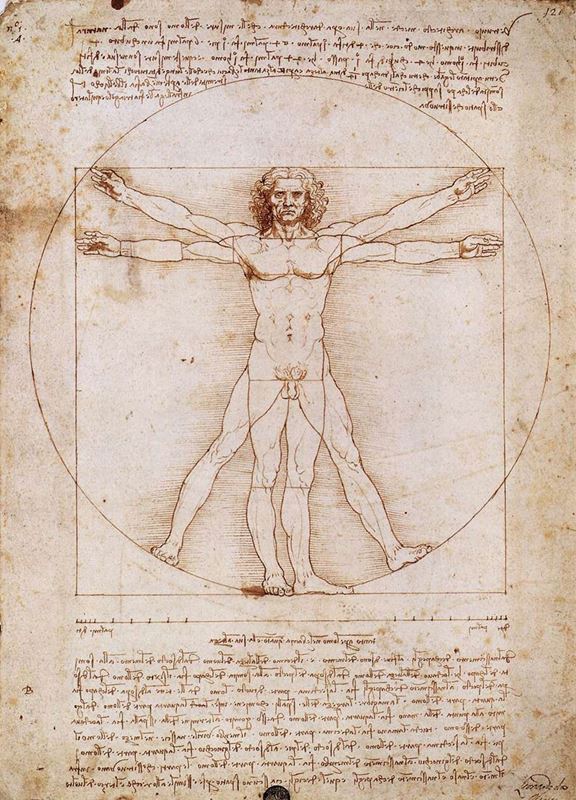The Vitruvian Man - Leonardo da Vinci
The Vitruvian Man, circa 1490, Gallerie dell'Accademia, Venice, Italy.
Leonardo da Vinci first began to work extensively on the proportions of the human body, anatomy and physiology in the late 1480s. In 1489 he began the preparation of a book titled "On the Human Figure". He could not finish the book, but he had made several drawings for this project. He began to examine the proportions of seated and kneeling bodies. He compared the results of his studies with the ratio-ratio theory of Vitruvius, one of the most important thinkers.
Marcus Vitruvius Pollio, an architect, engineer and thinker who lived in the Roman Empire, wrote a series of books on architecture. The third book of the series contained complete measurements of the human body.
According to Vitruvius' book, from these measurements, he concluded that a person with his arms and legs opened would fit in squares and circles. He argued that if the human body is shown in circle and square, the center of the body should be the belly of the human being. "The Vitruvian Man" one of Leonardo's most famous drawings, visualized and confirmed Vitruvius' assumptions in his work. In Leonardo's drawing, the center of the human body inside the circle coincided with the navel. The center of the human body inside the square was slightly below the navel.
The measurements of Vitruvius were described many times after the Renaissance. But the most well-known of these paintings was Leonardo's.
The drawing, made with ink on a large sheet of paper, depicted a single person in two different positions. Above and below the drawing were the following texts written by Leonardo:

"Vetruvio, architect, puts in his work on architecture that the measurements of man are in nature distributed in this manner, that is: Four fingers make a palm, four palms make a foot, six palms make a cubit. Four cubits make a man's height. Four cubits is make a pace and 24 palms make a man and these measurements are in his buildings". "If you open your legs enough that your head is lowered by one-fourteenth of your height and raise your hands enough that your extended fingers touch the line of the top of your head, know that the centre of the extended limbs will be the navel, and the space between the legs will be an equilateral triangle."

"The length of the outspread arms is equal to the height of a man."

"From the hairline to the bottom of the chin is one-tenth of the height of a man, from below the chin to the top of the head is one-eighth of the height of a man.
From above the chest to the top of the head is one-sixth of the height of a man.
From above the chest to the hairline is one-seventh of the height of a man. The maximum width of the shoulders is a quarter of the height of a man. From the breasts to the top of the head is a quarter of the height of a man. The distance from the elbow to the tip of the hand is a quarter of the height of a man. The distance from the elbow to the armpit is one-eighth of the height of a man. The length of the hand is one-tenth of the height of a man. The root of the penis is at half the height of a man. The foot is one-seventh of the height of a man. From below the foot to below the knee is a quarter of the height of a man. From below the knee to the root of the penis is a quarter of the height of a man. The distances from below the chin to the nose and the eyebrows and the hairline are equal to the ears and to one-third of the face."
Bibliography;
Zöllner, F., (2005). Leonardo, Birinci Basım, Taschen/Remzi Kitabevi, İstanbul.
Erdoğan, C.E., (2015). Sanatın Büyük Ustaları Leonardo da Vinci, Birinci Baskı, Hayalperest Yayınevi, İstanbul.
Nicholl, C., (2012). Aklın Uçuşları Leonardo da Vinci, İkinci Baskı, Everest Yayınları, İstanbul.
Suh, H.A., (2010). Leonardo’nun Defterleri, Birinci Baskı, Arkadaş Yayınevi, Ankara.













